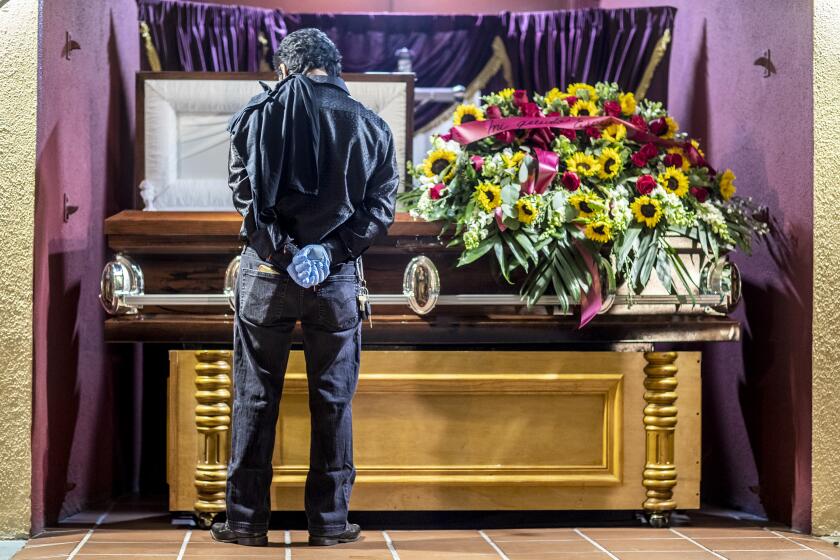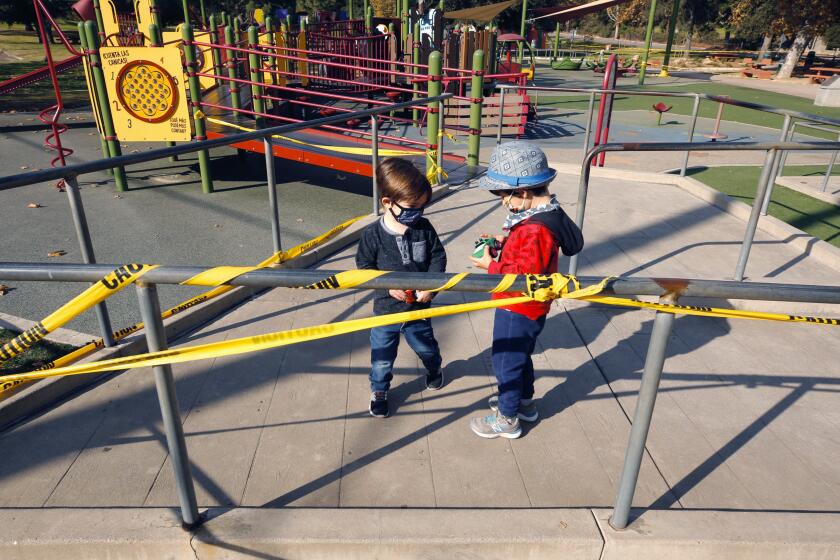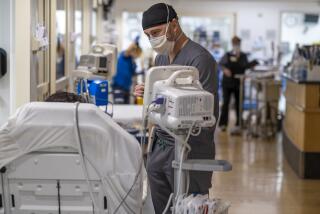California has its most coronavirus deaths in a single day as cases, hospitalizations continue to surge

- Share via
More Californians died of COVID-19 on Tuesday than any other day, the latest milestone in an accelerating pandemic that is infecting and hospitalizing residents at levels far eclipsing any seen before.
Tuesday’s death toll, 219, edged out the previous single-day high of 214, which was recorded July 31, according to data compiled by The Times.
The latest figure may be a harbinger of higher death tolls. Until this past week, California had topped 200 daily coronavirus-related deaths only two times. That number has been exceeded twice in the last five days.
The seven-day fatality average, 135 Californians a day over the last week, is also at a level not seen since the darkest days of the state’s summertime surge.
A month ago, the state was averaging about 44 daily deaths.
California on Tuesday shattered single-day records of coronavirus cases and deaths with the state’s worst tallies by far of the entire pandemic.
Nearly 1,400 Californians have died of COVID-19 in the last 14 days. Since the pandemic began, the disease has killed more than 20,300 statewide.
The death toll has been highest in Los Angeles, the state’s most populous county. More than 8,000 Angelenos have died of COVID-19 — a fact that nearly brought Public Health Director Barbara Ferrer to tears during a briefing Wednesday.
“Over 8,000 people who were beloved members of their families are not coming back,” she said, her voice choking. “And their deaths are an incalculable loss to their friends and their family, as well as our community.”
The sharp spike in fatalities seen over the last few weeks is the realization of what public health officials have long feared — that a massive surge of new coronavirus cases would not only swamp the state’s hospitals with patients but also swell the number of residents dying of the disease.
“As cases have continued to increase the past few weeks, we will bear witness to a significant rise in the number of people who are dying,” Ferrer said.
A stay-at-home order is issued for the Sacramento region under new state COVID-19 guidelines as the availability of ICU beds reaches a critical low.
Despite the overall increase in deaths, L.A. County officials said they believe the COVID-19 mortality rate has improved over the course of the pandemic, which they attributed to more experienced staff and wider knowledge about how best to care for patients.
Healthcare providers, for example, have learned that using mechanical ventilators — the availability of which was a topic of significant nationwide concern this year — “isn’t the best first option to someone who is struggling breathing,” said Dr. Christina Ghaly, the county director of health services.
“There’s a lot of treatments that have been shown to be helpful but, sadly, not every patient recovers,” she said Wednesday.
The number of fatalities is fueled by how many people are being infected — and there are more coronavirus cases now than at any other point in the pandemic.
On Nov. 3, L.A. County was reporting a seven-day COVID-19 average of about 800 hospitalizations and 10 deaths a day.
By Tuesday, the county was seeing a seven-day average of about 3,000 hospitalizations and more than 40 deaths a day.
“The mortality rate has gone down from COVID-19. Nonetheless, the link between cases, hospitalizations and then people dying is still there,” Ferrer said. “The more transmission you have, the more people are ending up in the hospital. And the more people that end up in the hospital, because those in the hospital are very sick, the more deaths we’re going to witness. And we’re seeing that play out right in front of us.”
Hospital ICUs full in Silicon Valley, Central Valley as state braces for more
Given the speed and ferocity with which the pandemic has worsened statewide, officials say it’s more important than ever for residents to protect themselves and their loved ones from becoming infected.
“Our message is: As much as you can, stay at home,” Dr. Mark Ghaly, California’s health and human services secretary, said Tuesday. “We know that it works. We know that we can bring our transmission rates down.”
Still, conditions statewide are continuing to deteriorate.
California recorded 34,490 new coronavirus cases Monday and an all-time daily high of 35,400 Tuesday. Before this week, the state had never reached 23,000 new cases in a single day.
Those figures are especially worrying given the time lag between infection and possible hospitalization and death. Typically, those who fall ill enough to require hospitalization do so two to three weeks after they are infected — meaning this week’s astronomically high case counts may trigger a new flood of patients later this month.
Already, California hospitals are caring for more COVID-19 patients than they ever have.
There are 11,012 coronavirus-positive patients hospitalized statewide, according to the latest tally, with 2,506 of those in intensive care. Both of those figures are all-time highs.
As with cases, it’s not just the raw numbers that are concerning for public health officials but also the rate of growth.
Over the last two weeks, the number of people hospitalized with the coronavirus has grown by 78%. Intensive care admissions are up 75% over that same period.
Though hospitals can expand their capacities should the need arise, their ability to do so isn’t infinite. They are further constrained when it comes to ICU beds, which require specially trained healthcare professionals and high-tech equipment and are especially critical for patients with severe cases of COVID-19, who may require ventilators and round-the-clock care.
Amid the continuing crush of COVID-19 patients, some ICUs are already feeling the crunch.
At least three counties in the San Joaquin Valley had reached zero capacity as of Tuesday. That same day, Santa Clara County was down to 31 available intensive care unit beds — just 9.5% left of its capacity — to serve Northern California’s most populous county, home to nearly 2 million people.
“All the things that you’re hearing about how impacted our hospitals are, about how dire this situation with our ICUs is — it’s absolutely true,” said Dr. Rais Vohra, the Fresno County Department of Public Health’s interim health officer.
The potential strain on that precious resource is why the state made ICU numbers the trigger for its latest round of coronavirus-related restrictions.
Under the new system, officials divided the state into five regions: Southern California, the San Joaquin Valley, the Bay Area, the Greater Sacramento area and rural Northern California.
Should a region’s available ICU capacity drop below 15%, it is required to implement a stay-at-home order, which restricts retail capacity to 20% and shuts down outdoor restaurant dining, hair salons, nail salons, card rooms, museums, zoos, aquariums and wineries.
Public outdoor playgrounds were originally listed among the areas that would have to close, but the state reversed that requirement in new guidance released Wednesday morning. L.A. County officials announced Wednesday that they would also reopen playgrounds.
Facing backlash from parents, the state of California reverses its COVID-19 rules and says playgrounds can remain open.
Already, the new stay-at-home restrictions have been implemented in the Southern California and San Joaquin Valley regions. Those areas had seen their ICU availabilities tumble to 9% and 4.2%, respectively, as of Wednesday morning.
Greater Sacramento — which encompasses Alpine, Amador, Butte, Colusa, El Dorado, Nevada, Placer, Plumas, Sacramento, Sierra, Sutter, Yolo and Yuba counties — dipped to 14.3% ICU availability as of Wednesday, according to the state. The stay-at-home order will take effect in that region at 11:59 p.m. Thursday.
Five Bay Area counties — San Francisco, Santa Clara, Contra Costa, Alameda and Marin — have proactively implemented the new restrictions.
The other state-defined regions remain above the 15% threshold for now, but officials warn that could quickly change and that the stakes for all Californians remain high.
“It is the worst we have seen, and it’s continuing to worsen,” said Dr. Ahmad Kamal, Santa Clara County’s director of health preparedness. “Hospitals are nearing capacity, our staffing is stretched thin — not just in our county, but throughout the state and throughout the nation.”
Times staff writers Faith E. Pinho and Lila Seidman contributed to this report.
More to Read
Sign up for Essential California
The most important California stories and recommendations in your inbox every morning.
You may occasionally receive promotional content from the Los Angeles Times.



















